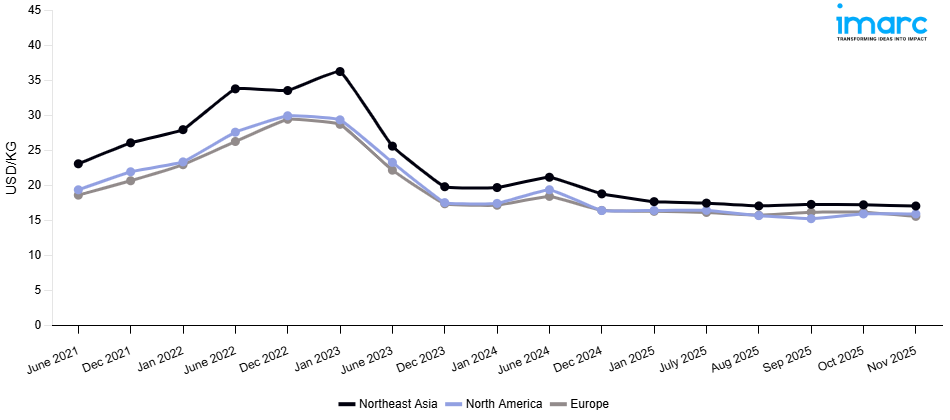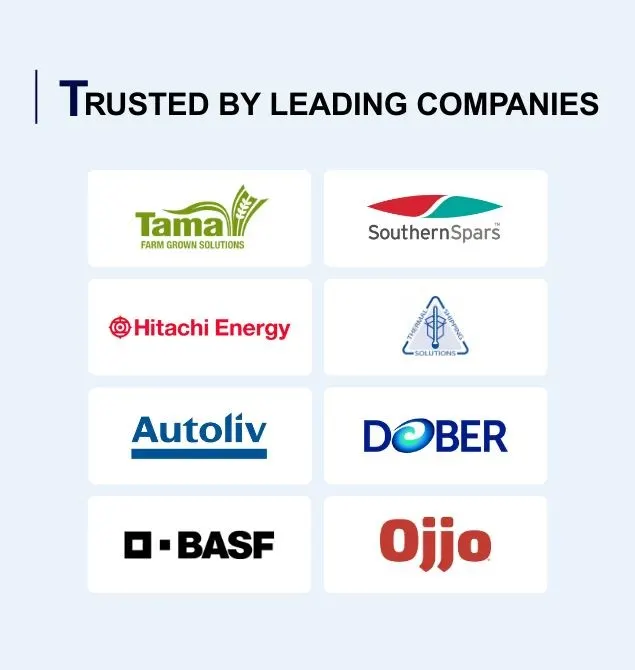
Nickel Prices, Trend, Chart, Demand, Market Analysis, News, Historical and Forecast Data Report 2025 Edition
Nickel Price Trend, Index and Forecast
Track real-time and historical nickel prices across global regions. Updated monthly with market insights, drivers, and forecasts.
Nickel Prices November 2025
| Region | Price (USD/KG) | Latest Movement |
|---|---|---|
| Northeast Asia | 17.07 | -1.0% ↓ Down |
| Europe | 15.59 | -3.7% ↓ Down |
| North America | 15.94 | Unchanged |
Nickel Price Index (USD/KG):
The chart below highlights monthly nickel prices across different regions.

Get Access to Monthly/Quaterly/Yearly Prices, Request Sample
Market Overview Q3 Ending September 2025
Northeast Asia: Nickel prices in Northeast Asia showed a moderate upward trend. The regional market was heavily influenced by robust stainless-steel production in China and South Korea, which together account for a substantial portion of global nickel demand. Demand-side pressures were supported by increasing requirements from the electric vehicle (EV) battery segment, where nickel-intensive NMC (Nickel-Manganese-Cobalt) chemistries remained dominant. On the supply side, shipments from Indonesia, the world’s largest nickel producer, encountered logistical challenges due to port congestion and regulatory checks on new smelting capacity. These disruptions contributed to higher procurement costs for Northeast Asian buyers. Furthermore, currency fluctuations in the Japanese yen and South Korean won against the US dollar raised import bills, thereby amplifying domestic price adjustments.
Europe: In Europe, nickel prices firmed more sharply. This increase was largely tied to persistent energy costs, particularly in Germany and France, which continued to drive higher smelting and refining expenses. The European stainless-steel sector reported stable production, but procurement for nickel-bearing alloys in aerospace and defense applications added incremental demand pressures. Domestic logistics in Europe, including road freight challenges in central EU regions, further inflated distribution costs. Currency fluctuations against the US dollar, compounded the upward trend by raising landed costs of dollar-denominated imports. Additionally, compliance with EU sustainability frameworks such as carbon border adjustment mechanisms (CBAM) added regulatory expenses for downstream buyers.
North America: In North America, nickel prices declined. The dip was indicative of weak industrial demand, especially from the stainless steel sector, a historically dominant consumer of nickel, which faced prolonged sluggishness. Although there was some resilience in battery-related uptake due to the shift to LFP chemistries that sidelined nickel, dampening emerging demand growth. On the supply side, North American markets were impacted by sharply lower prices, which strained operating margins. Despite occasional positive tariff developments that provided temporary relief, broader market dynamics remained bearish, weighed down by inventory build-up and oversupply. As such, the North American nickel market remained firmly in a downtrend.
Nickel Price Trend, Market Analysis, and News
IMARC's latest publication, “Nickel Prices, Trend, Chart, Demand, Market Analysis, News, Historical and Forecast Data Report 2025 Edition,” presents a detailed examination of the nickel market, providing insights into both global and regional trends that are shaping prices. This report delves into the spot price of nickel at major ports and analyzes the composition of prices, including FOB and CIF terms. It also presents detailed nickel prices trend analysis by region, covering North America, Europe, Asia Pacific, Latin America, and Middle East and Africa. The factors affecting nickel pricing, such as the dynamics of supply and demand, geopolitical influences, and sector-specific developments, are thoroughly explored. This comprehensive report helps stakeholders stay informed with the latest market news, regulatory updates, and technological progress, facilitating informed strategic decision-making and forecasting.
.webp)
Nickel Industry Analysis
The global nickel industry size reached 3.76 Million Tons in 2025. By 2034, IMARC Group expects the market to reach 4.55 Million Tons, at a projected CAGR of 2.16% during 2026-2034. The market is driven by rising stainless steel production, expanding demand from electric vehicle batteries, and increasing use in high-performance alloys for aerospace and energy applications.
Latest developments in the nickel industry:
- March 2025: Panasonic Energy and Sumitomo Metal Mining initiated a collaborative project to recover nickel from lithium-ion battery production waste. This process, starting with scrap from Panasonic's Osaka plant, will be processed at Sumitomo's Niihama Nickel Refinery, contributing to a closed-loop economy in battery manufacturing.
- November 2023: Eramet, the French mining and metallurgy company, announced that it would spend USD 2 billion on expanding its nickel and lithium production to meet the rising demand for electric vehicles. The company had plans to increase its Ni and Li production capacity by 50% and 90% in the same year.
- June 2023: Rolled Alloys Inc. received a new certification, ISO 9001:2015/AS 9100:D, for its quality management system. This certification is specifically for the company's manufacturing and distribution of heavy metals mill products made from stainless steel and nickel alloys.
Product Description
Nickel is a lustrous, silvery-white metallic element, classified among base metals. It stands as a critical material in global industrial consumption, most prominently in stainless steel, specialty alloys, plating, and battery technologies. Nickel’s defining properties include strong corrosion resistance, high-temperature durability, and alloying flexibility. It enhances product performance across sectors: strengthening stainless steel for infrastructure and consumer goods, enabling high-performance alloys in aerospace, providing protective plating solutions, and boosting energy density in lithium-ion battery cathodes—thereby improving longevity and efficiency.
Report Coverage
| Key Attributes | Details |
|---|---|
| Product Name | Nickel |
| Report Features | Exploration of Historical Trends and Market Outlook, Industry Demand, Industry Supply, Gap Analysis, Challenges, Nickel Price Analysis, and Segment-Wise Assessment. |
| Currency/Units | US$ (Data can also be provided in local currency) or Metric Tons |
| Region/Countries Covered | The current coverage includes analysis at the global and regional levels only. Based on your requirements, we can also customize the report and provide specific information for the following countries: Asia Pacific: China, India, Indonesia, Pakistan, Bangladesh, Japan, Philippines, Vietnam, Thailand, South Korea, Malaysia, Nepal, Taiwan, Sri Lanka, Hongkong, Singapore, Australia, and New Zealand* Europe: Germany, France, United Kingdom, Italy, Spain, Russia, Turkey, Netherlands, Poland, Sweden, Belgium, Austria, Ireland, Switzerland, Norway, Denmark, Romania, Finland, Czech Republic, Portugal and Greece* North America: United States and Canada Latin America: Brazil, Mexico, Argentina, Columbia, Chile, Ecuador, and Peru* Middle East & Africa: Saudi Arabia, UAE, Israel, Iran, South Africa, Nigeria, Oman, Kuwait, Qatar, Iraq, Egypt, Algeria, and Morocco* *The list of countries presented is not exhaustive. Information on additional countries can be provided if required by the client. |
| Information Covered for Key Suppliers |
|
| Customization Scope | The report can be customized as per the requirements of the customer |
| Report Price and Purchase Option |
Plan A: Monthly Updates - Annual Subscription
Plan B: Quarterly Updates - Annual Subscription
Plan C: Biannually Updates - Annual Subscription
|
| Post-Sale Analyst Support | 360-degree analyst support after report delivery |
| Delivery Format | PDF and Excel through email (We can also provide the editable version of the report in PPT/Word format on special request) |
Key Benefits for Stakeholders:
- IMARC’s report presents a detailed analysis of nickel pricing, covering global and regional trends, spot prices at key ports, and a breakdown of FOB and CIF prices.
- The study examines factors affecting nickel price trend, including input costs, supply-demand shifts, and geopolitical impacts, offering insights for informed decision-making.
- The competitive landscape review equips stakeholders with crucial insights into the latest market news, regulatory changes, and technological advancements, ensuring a well-rounded, strategic overview for forecasting and planning.
- IMARC offers various subscription options, including monthly, quarterly, and biannual updates, allowing clients to stay informed with the latest market trends, ongoing developments, and comprehensive market insights. The nickel price charts ensure our clients remain at the forefront of the industry.
Key Questions Answered in This Report
The nickel prices in November 2025 were 17.07 USD/Kg in Northeast Asia, 15.59 USD/Kg in Europe, and 15.94 USD/Kg in North America.
The nickel prices data is updated on a monthly basis.
We provide the pricing data primarily in the form of an Excel sheet and a PDF.
Yes, our report includes a forecast for nickel prices.
The regions covered include North America, Europe, Asia Pacific, Middle East, and Latin America. Countries can be customized based on the request (additional charges may be applicable).
Yes, we provide both FOB and CIF prices in our report.
Need more help?
- Speak to our experienced analysts for insights on the current market scenarios.
- Include additional segments and countries to customize the report as per your requirement.
- Gain an unparalleled competitive advantage in your domain by understanding how to utilize the report and positively impacting your operations and revenue.
- For further assistance, please connect with our analysts.
Why Choose Us
IMARC offers trustworthy, data-centric insights into commodity pricing and evolving market trends, enabling businesses to make well-informed decisions in areas such as procurement, strategic planning, and investments. With in-depth knowledge spanning more than 1000 commodities and a vast global presence in over 150 countries, we provide tailored, actionable intelligence designed to meet the specific needs of diverse industries and markets.
1000
+Commodities
150
+Countries Covered
3000
+Clients
20
+Industry
Robust Methodologies & Extensive Resources
IMARC delivers precise commodity pricing insights using proven methodologies and a wealth of data to support strategic decision-making.
Subscription-Based Databases
Our extensive databases provide detailed commodity pricing, import-export trade statistics, and shipment-level tracking for comprehensive market analysis.
Primary Research-Driven Insights
Through direct supplier surveys and expert interviews, we gather real-time market data to enhance pricing accuracy and trend forecasting.
Extensive Secondary Research
We analyze industry reports, trade publications, and market studies to offer tailored intelligence and actionable commodity market insights.
Trusted by 3000+ industry leaders worldwide to drive data-backed decisions. From global manufacturers to government agencies, our clients rely on us for accurate pricing, deep market intelligence, and forward-looking insights.
 Request Customization
Request Customization
 Inquire Before Buying
Inquire Before Buying
 Speak to an Analyst
Speak to an Analyst Request Brochure
Request Brochure




.webp)




.webp)












